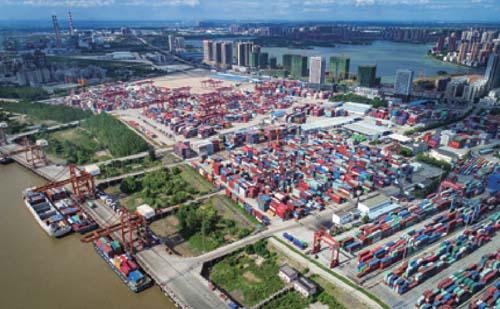Green Belt
2018-10-18ByChengChangchun
By Cheng Changchun

President Xi Jinping elaborated on the national strategy of developing the Yangtze River Economic Belt as part of efforts to achieve national rejuvenation in his April 26 speech in Wuhan, capital of central Chinas Hubei Province. Xi analyzed the problems and challenges facing the development of this area. He stressed that it must avoid overexploitation, develop in a well-protected environment and never cross the ecological red line.
Confronting challenges
The Yangtze River Economic Belt is a typical basin economy that involves waterways, roads, ports, riverbanks, industries, cities, biology, wetlands and the environment. Its population and GDP both account for 40 percent of the countrys total. The belt passes through 11 provinces and municipalities, with hundreds of big, medium and small cities, linking Chinas north, south, west and east. In the 1990s, each city launched its own development plan. Though economic cooperation zones and city circles were established in certain areas, enthusiasm for integrative development of a broader area was not high, which, to some extent, resulted in homogenized and fragmented industries.
In recent years, the Yangtze River Economic Belt was over-burdened with shipping, hydraulic engineering, mining and electricity generation, among other functions. Industrial parks and heavy chemical industries were built and hazardous chemicals shipped, both of which posed hidden dangers to the area. These problems are closely linked with public safety, economic development and social security, calling for a change in the current disjointed management mode along the belt. Moreover, there is still great potential along the Yangtze River, with less than 20 percent of its capacity tapped.
The Yangtze River Delta pools many talent, universities and research institutions, giving it a technology- and knowledge-intensive economy. The next step is to prioritize the service economy. The other two cross-regional city clusters, the middle reaches of the Yangtze River and Chengdu-Chongqing, and the two regional city groups, central Guizhou and Yunnan, lag behind in the secondary and tertiary industries. In the upper reaches of the Yangtze River, industrialization and urbanization remain the focus. This regional imbalance is an obstacle to the realization of green development along the belt.
Sustainable development
At the 2014 Central Economic Work Conference, the construction of the Yangtze River Economic Belt was elevated to a national strategy. Since then, it has embarked on the path of coordinating ecological protection with the goal of green and sustainable development.
Notable results have been achieved in ecological protection and restoration. Water quality in 22 key sections along the Yangtze Rivers main stream all meets or exceeds the third grade, a standard for the sources of drinking water. The PM2.5 and PM10 concentration in eight provinces and cities along the river dropped, with major pollutants in six provincial capital cities reduced by 2 percent year on year. The green development index in 11 provinces and cities averaged 80.4 in 2016. The area has also taking the lead nationwide in seven realms, including resource utilization and environmental management. The annual rankings in ecological development of seven provinces and cities made it to the top 10 nationwide.
Chinas independent innovation capability is also continuously improving. While planning the layout of a national center for manufacturing innovation, the country has also sped up the building of the Shanghai Zhangjiang Comprehensive National Science Center, the Hefei Comprehensive National Science Center and national laboratories for marine engineering and air pollution monitoring.
In addition, cities along the Yangtze River have carried out policies to support the development of the intelligent industry. In Shanghai, intelligent manufacturing projects have been initiated; in Wuhan, a City of Robots is being forged with a focus on industrial robots; in Hefei, a Chinese Speech Valley jointly built by the Ministry of Industry and Information Technology and the Anhui Provincial Government will serve as a foothold for the development of the intelligent industry.
In 2015, the proportion of the tertiary industry exceeded that of the secondary one for the first time in the region, a big change in the industrial structure. In 2016, the ratio of the three industries was 8.10:42.88:49.02, a decrease of 1 percent in the primary industry, 6.2 percent in the secondary industry and an increase of 7.2 percent in the tertiary one compared to 2012.
The rapid development of the emerging industry lends support to the development of the belt. Specifically, next-generation information technologies, such as integrated circuits, panel displays, the Internet of Things, cloud computing, artificial intelligence and Big Data, have gathered momentum in Chongqing, Wuhan, Hefei, Nanjing and Shanghai. The Wuhan Optics Valley excels in photoelectronics, for example.
The Yangtze River Economic Belt is the main battlefield for achieving a new type of urbanization. It is moving forward rapidly, persisting with green development, a steady increase in economic aggregate, rapid per-capita GDP growth and strong local finance. By the end of 2016, the urbanization levels in several cities along the belt were higher than the national average of 57.4 percent. Shanghai was at 87.9 percent, Jiangsu at 67.7 percent, Zhejiang at 67.0 percent, Chongqing at 62.6 percent and Hubei at 58.1 percent. In January 2016, an interprovincial consultation and cooperation mechanism covering the whole river basin was initiated and a basic framework for multilevel coordination was created.
Quality development
Under the guidance of Xis Wuhan speech, the Yangtze River Economic Belt is adhering to the principle of prioritizing ecological protection and green development. Through coordinated and balanced development, it aims to improve the quality of economic progress, increasing its efficiency and transforming growth drivers to build itself into a zone with good ecology, streamlined transportation, a coordinated economy, a unified market and sound institutions.
Measures to be undertaken include promoting green development in the Yangtze River Economic Belt in a coordinated and balanced way and protecting its ecological environment. Joint prevention and control of pollution and comprehensive management of the environment will be strengthened, promoting water pollution treatment, repair of the aquatic ecology and protection of aquatic resources. A negative list will be introduced and the most strict regulations and laws will be implemented to establish harmonious relations between people and nature and a green ecological corridor.
Furthermore, promoting green, cyclic and low-carbon regional development will also be a priority. This will include making full use of market-oriented means; improving the mechanisms of pricing, resources and the environment; upgrading traditional industries; and promoting technological innovation and green finance.
It is crucial to improve the multi-mode transport system and build a safe, convenient, green and low-carbon comprehensive transport network. There is a strategy to integrate the concept of ecological progress into the construction of an urban agglomeration along the Yangtze River Economic Belt, including a worldclass urban agglomeration ecosystem in the Yangtze River Delta. The region aims to become a resource-conserving and environmentallyfriendly area and an ecological shield in the middle reaches of the Yangtze River.
Balanced and coordinated development also promotes regional pooling of resources for science and technology and innovation. A cooperation mechanism will be established and advanced to improve the efficiency of coordinated innovation. It will give full play to the leading role of the Shanghai Global Center for Science and Innovation and build a crossregional innovation cooperation alliance. Its goal is to develop the core technologies of intelligent manufacturing, new energy, new materials, the Internet of Things, Big Data and aerospace. It will collaboratively conduct scientific research and industrialization application demonstration. At the same time, the region will strengthen sup- port for innovative capital, market and talent to foster and expand green technology innovation players and for industrial transformation and upgrading.
World-class manufacturing innovation centers and science and technology think tanks at important nodes will be set up. In 10 provincial capital cities and municipalities directly under the Central Government, a networked layout will be designed to make comprehensive manufacturing innovation centers and build a manufacturing innovation network covering the whole basin in order to meet the needs of the development of regional innovation engines.
Additionally, a coordinated and balanced modern economic system is planned. It will accelerate the building of a unified big market. This calls for breaking administrative barriers between regions, accelerating interconnectivity, advancing a river port transportation system, building a comprehensive transportation corridor and improving the functions of the golden waterway and traffic hubs. Industrial transfer and flow of production factors will also be accelerated. Support will be given to strategic cooperation in building industrial parks and industrial enclaves to forge complementary advantages and promote win-win cooperation in the region.
To advance supply-side structural reform along the belt, the government will, on the one hand, support reform and innovation and find new growth drivers. At the same time, it will cut backward and excess production capacity. It will endeavor to form a modern industrial corridor with a high degree of agglomeration and strong international competitiveness. It will promote the centralized treatment and recycling of waste in industrial parks and push forward industrial transformation and upgrading along the river. Concerted efforts will be made to expand production services in the basin and shift manufacturing from production-oriented to serviceoriented. Relying on the construction of a top urban agglomeration, where different regions advance their own respective advantages to strive for coordinated and high-quality development, a world-class industrial cluster will be built.
A new pattern of opening up of the Yangtze River Economic Belt will be shaped by harmonious and balanced development. The building of free trade zones (FTZ) will be accelerated, and as the 11 provinces and cities along the river overlap with the five FTZs in Shanghai, Zhejiang, Hubei, Chongqing and Sichuan, there will be good opportunities to create an international, market-oriented and law-based business environment. As a result, the orderly opening up of public and production services, finance and the enhancement of the functions of the FTZs will be promoted. Free trade ports will also be built to elevate the belts open economy to a higher level.
All of these measures will sync effectively with the massive transnational undertaking of the Belt and Road Initiative. It will act as a catalyst, complementing activity that promotes development under the initiative. It will be the foundation upon which these once-in-an-era undertakings will flourish and reach their developmental potential.
